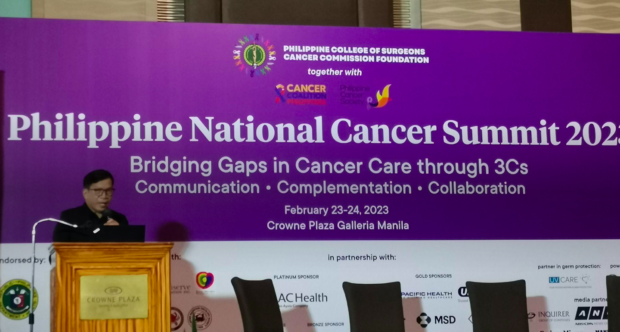The Philippine College of Surgeons Cancer Commission Foundation, together with Cancer Coalition Philippines and Philippine Cancer Society, held a 2-day Philippine National Cancer Summit to discuss with healthcare providers and esteemed medical professionals the ways to bridge the gaps in cancer care in the Philippines.

Dr. Efren Domingo, Gynecologist – Oncologist, discusses the state of cervical cancer detection, care, and treatment in the Philippines
According to the International Agency for Research on Cancer, breast, lung, colorectum, liver, and prostate cancers are the top cancer cases in the Philippines in 2020. These, and other types of cancers, result in over 92,00 deaths. Apart from the top 5 cancer types, cervical cancer is another contributor to this number.
Cervical cancer ranks second among the most frequently diagnosed cancer in women. There is a risk of cervical cancer when a female is infected with HPV human papillomavirus (HPV). The immune system usually detects and controls this infection. However, when the body’s immune system is weakened, high-risk HPV infects cells and could turn into pre-cancerous cells. In a year, an estimated 7, 897 cases of cervical cancer among women of all ages, and 4,052 of those can result in death.
To reduce these numbers, the World Health Organization (WHO) created the Cervical Cancer Elimination Initiative where 90% of girls must be fully vaccinated against HPV by 15 years old; 70% of women must be screened twice within 5 to 10 years, and 90% of women with pre-cancer are treated and 90% of women with invasive cancer are managed by 2030.
In line with this, Dr. Efren J. Domingo, Gynecologist-oncologist, discussed in a lunch symposium sponsored by healthcare company MSD in the Philippines, the state of cervical cancer detection, care, and treatment here in the country in his lecture, “Pursuing the Goal of Cervical Cancer Elimination in the Philippines.”
He shared about how the age of sexually active females became earlier over time. In his presentation, it was discussed that female adolescents ages 14 to 15 are already sexually active, therefore having a higher chance of encountering HPV. HPV 16 and 18 are two of the high-risk HPVs commonly responsible for cervical cancer.
Early protection and screening are essential to achieving a higher survival rate. A study has shown how the HPV vaccine has greatly reduced the incidence of cervical cancer by up to 90% in a sample size of 1.7 million women under age 17. Dr. Domingo also shared how early detection also allows oncologists to implement the best solution for early-stage cancer up to Stage IIA: surgery. This procedure greatly reduces the capacity of the cancer to spread to the lungs, liver, and brain.
“In the Philippines, because of our national handicap, our coverage of vaccination is still far from ideal. We still have to reach out to the younger women to capture the best protection before they meet the culprit virus,” Dr. Domingo mentioned.
Furthermore, based on Dr. Domingo’s lecture, while the government started vaccinating women in 2006, the country’s archipelagic nature hinders organizations and medical professionals from reaching out to more women across the country. Expenses for the vaccine and testing also come from the patient, which influences them to no longer get the vaccine and test.
As such, women frequently consult late and are later diagnosed when the cancer has become advanced.
Fortunately, there is hope for advanced, recurrent cancer.
Chemoradiotherapy is the standard regimen in treating advanced cancer. It is a combination of chemotherapy where the oncologist administers cancer-destroying drugs, and radiotherapy, where radiation is used to destroy cancer cells.
The GOG 240 trial has also shown significant results in the advanced cancer patient’s survival rate. In the GOG 240 trial, using various immunotherapy drugs together showed significant results in the patient’s survival rate.
Since multi-modal treatment has a high efficacy rate, Dr. Domingo also shared how the implementation of immunotherapy, in addition to chemoradiotherapy, could bring hope to advanced cervical cancer patients.
“First-line treatment should be the present treatment for those with the complicated disease profile,” Dr. Domingo stated. He added that immunotherapy, together with chemoradiotherapy, should be used as first-line treatment in cases of advanced recurring cancer.
“From the 1999 clinical announcement of a chemotherapy drug as the most remarkable achievement against cervical cancer, the next event happens now in our time. We are lucky to witness it. Together with chemotherapy, the administration of immunotherapy will achieve probably the biggest hope of a cure for the patients of this otherwise hopeless disease.”
Dr. Domingo believes that with this line of treatment, WHO’s 90-70-90 goal by 2030 is achievable through the support of the government and the private sector. This, along with the implementation of the Universal Healthcare Law and the National Integrated Cancer Control Act, cervical cancer vaccination, screening, and treatment for all Filipino women is a plausible future.
ADVT.
Read more stories here:
World Immunization Week 2023 celebrations kick off in Pangasinan and Cebu
vivo leads smartphone innovations
Filigree creates luxe estate in Clark with Golf Ridge